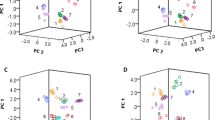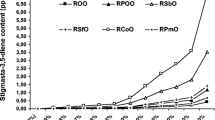Abstract
Authentication of virgin coconut oil (VCO) is imperative to protect the interests of the consumers. An investigation was carried out to distinguish VCO from coconut oil (CO), palm oil (PO) and liquid paraffin utilizing biochemical quality parameters, including fatty acid composition, and principal component analysis (PCA). Various oil blends of VCO: PO, VCO: CO (both in 10% increments), VCO:CO:PO and VCO: liquid paraffin and CO: liquid paraffin were prepared. The oil blends were analyzed for quality features, fatty acid composition and the data was analyzed statistically. Biochemical attributes such as total phenolic content (TPC), total flavonoid content (TFC), iodine value (IV) and saponification value (SV) and fatty acids like lauric acid, myristic acid, palmitic acid and oleic acid were influential parameters to distinguish the oil samples at various levels of adulteration. Samples could be classified even with the adulteration level of as low as 10%. Principal component analysis produced two components distinguishing various adulterated oil samples. Multiple regression analysis provided predictive equation models with high coefficient of determination (R2) and could help in adulteration quantitation. Hence, this study demonstrated the efficacy of chemometrics approach in distinguishing VCO from possible adulterants like PO, CO and liquid paraffin.








Similar content being viewed by others
Data Availability
All the data described in this research work is available within this manuscript.
References
Agarwal RK, Bosco SJD (2017) Extraction processes of virgin coconut oil. MOJFPT 4(2):1–3
AjogunCO ASC, Kiin-Kabari DB, Akusu OM (2020) Effect of Extraction Methods on the Physicochemical Properties, Fatty Acid Profile and Storage Stability of Virgin Coconut Oil. Asian Food Sci J 18(4):27–40
Anonymous (2020) https://www.coconutboard.in/ accessed on 21/10/2020, 3:00 pm
Anonymous, amended (2009) Asian and Pacific Coconut Community standard for virgin coconut oil. (https://www.academia.edu/31872585/VIRGIN_COCONUT_OIL_Asian_and_Pacific_Coconut_Community). Accessed on 05/06/2022
Anonymous, amended (1999) Alimentarius, Codex. “Codex standard for named vegetable oils”. Codex Stan 210:1–13.
Bharti ID, Solanki RL, Meena BS (2017) A Comparative Impact Study of Edible Oils on Health. Int J Curr Microbiol App Sci 6(11):601–612
Dia VP, Garcia VV, Mabesa RC, Tecson-Mendoza EM (2005) Comparative physicochemical characteristics of virgin coconut oil produced by different methods. Philipp Agric Sci 88(4):462–475
Haryati T, Che Man YB, Ghazali HM, Asbi BA, Buana L (1998) Determination of iodine value of palm oil based on triglyceride composition. J Am Oil Chem Soc 75(7):789–792
https://coconutboard.gov.in/Statistics.aspx/Coconut development board, accessed on 16/09/2022 at 3:00 pm.
https://www.statista.com/statistics/875977/organic-virgin-coconut/Statista, accessed on 20/12/2021 at 12:00 noon
Jayatunga HGTH, Somasiri HPPS, Mahanama KRR (2020) Rapid determination of adulteration in virgin and copra coconut oil using Fourier transform near infrared spectroscopy. Int J Food Sci Nutr 5(3):38–43
Koh SP, Long K (2012) Oxidative stability study of virgin coconut oil during deep frying. J Trop Agric Fd Sc 40(1):35–44
Koushki M, Nahidi M, Cheraghali F (2015) Physico-chemical properties, fatty acid profile and nutrition in palm oil. Arch Adv Biosci 6(3):117–134
Krishna AG, Raj G, Ajit SB, Kumar PK, Chandrashekar P (2010) Coconut Oil: Chemistry, production and its applications. Indian Coconut J 53(3):15–27
Kumar N (2007) Capillary gas chromatography method for fatty acid analysis of coconut oil. J Plant Crops 35(1):23–27
Landau S, Everitt BS (2003) A handbook of statistical analyses using SPSS. Chapman and Hall/CRC.Pp 366, New York. https://doi.org/10.1201/9780203009765
Lechhab T, Lechhab W, Trovato E, Salmoun F, Mondello L, Cacciola F (2022) Impact of edaphoclimatic conditions and crop season on olive oil’s fatty acids. Agronomy J 114:3118–3128
Lechhab T, Lechhab W, Trovato E, Salmoun F, Mondello L, Cacciola F (2022) Screening of the Volatile Composition of Moroccan Olive Oils by Using SPME/GC-MS-FID over a Two-Year Period: A Pedoclimatic Discrimination. Horticulture 8:925
Libish TM, Linesh J, Bobby MC, Biswas P, Bandyopadhyay S, Dasgupta K, Radhakrishnan P (2011) Detection and analysis of paraffin oil adulteration in coconut oil using fiber optic long period grating sensor. Optik 122(21):1939–1942
Man YBC, Manaf MA (2006) Medium-chain triacylglycerols. CRC Press, In Nutraceutical and specialty lipids and their co-products, pp 27–56
Manaf MA, Man YBC, Hamid NSA, Ismail A, Abidin SZ (2007) Analysis of adulteration of virgin coconut oil by palm kernel olein using Fourier transform infrared spectroscopy. J Food Lipids 14(2):111–121
Manikantan MR, Mathew AC, Madhavan K, Arumuganathan T, Arivalagan M, Shameena PP, Hebbar KB (2016) Virgin coconut oil hot and fermentation process. Technical bulletin no. 108, Centenary Publication 43, ICAR-Central Plantation Crops Research Institute, AICRP on PHET, Kasaragod 1–36
Marikkar JMN (2019) Differential Scanning Calorimetric Analysis of Virgin Coconut Oil, Palm Olein, and their Adulterated Blends. CORD 35(01):9
Marikkar JMN, Yanty NAM (2018) Principal component analysis of fatty acid data to detect virgin coconut oil adulteration by palm olein. CORD 34(1):30–38
Marina AM, Man YBC, Nazimah SAH, Amin I (2009) Monitoring the adulteration of virgin coconut oil by selected vegetable oils using differential scanning calorimetry. J Food Lipids 16(1):50–61
Nevin KG, Rajamohan T (2006) Virgin coconut oil supplemented diet increased the antioxidant status in rats. Food Chem 99:260–266
Pandurangan MK, Murugesan S, Gajivaradhan SN (2017) Detection of adulteration of coconut oil using Fourier transform infrared spectroscopy and chemometrics. Mater Sci 2(6):46–51
Ramesh SV, Krishnan V, Praveen S, Hebbar KB (2021) Dietary prospects of coconut oil for the prevention and treatment of Alzheimer’s disease (AD): a review of recent evidences. Trends Food Sci Technol 112:201–211
Ramesh SV, Mary R, Beegum S, Pandiselvam R, Sugatha P, Neenu S, Shil S, Niral V, Manikantan MR, Lokesha AN, Shivashankara KS, Hebbar KB (2022) Physicochemical characterization and fatty acid profiles of testa oils from various coconut (Cocos nucifera L.) genotypes. J Sci Food Agric 103(1):370–379. https://doi.org/10.1002/jsfa.12150
Ramesh SV, Krishnan V, Praveen S, Hebbar KB (2019) Coconut oil–scientific facts. Curr Sci 117(4):564–565
Ramesh SV, Pandiselvam R, Thushara R, Manikantan MR, Hebbar KB, Beegum S, Mathew AC, Neenu S, Shil S (2020) Engineering intervention for production of virgin coconut oil by hot process and multivariate analysis of quality attributes of virgin coconut oil extracted by various methods. J Food Process Eng 43(6):1–10
Rohman A, Man YBC, Ali YMD (2019) The authentication of virgin coconut oil from grape seed oil and soybean oil using FTIR spectroscopy and chemometrics. Int J App Pharm 11(2):259–263
Santos JER, Villarino BJ, Zosa AR, Dayrit FM (2011) Analysis of volatile organic compounds in virgin coconut oil and their sensory attibutes. Philipp J Sci 140(2):161–171
Seneviratne KN, Hapuarachchi CD, Ekanayake S (2009) Comparison of the phenolic-dependent antioxidant properties of coconut oil extracted under cold and hot conditions. Food Chem 114(4):1444–1449
Srivastava Y, Semwal AD, Majumdar A (2016) Quantitative and qualitative analysis of bioactive components present in virgin coconut oil. Cogent Food Agric 2(1):1–13
Virginia MR, Karina SH, Horacio ST, Tomás QB, Concepción CC (2013) Lipids data composition of edible ant eggs, Liometopum apiculatum. M Escamoles J Life Sci 7(5):547
Zannat MM, Nandi R, Ashik-E-Rabbani M, Awal MA (2019) Performance evaluation of a motor operated oil palm crusher. Progress Agric 30(3):317–327
Zhishen J, Mengcheng T, Jianming W (1999) The determination of flavonoid contents in mulberry and their scavenging effects on superoxide radicals. Food Chem 64(4):555–559
Funding
This work was supported by funding from ICAR-Central Plantation Crops Research Institute (ICAR-CPCRI Grant No: 1000766014).
Author information
Authors and Affiliations
Contributions
Study design and conceptualization: KBH, V, AKS & SVR; investigation: CMB, SVR; data analysis CMB, GSC, VJ, drafting of various sections of the manuscript: All authors and; Read and approved the final version of the manuscript: All authors.
Corresponding authors
Ethics declarations
Conflict of Interest
M.B. Cariappa declares that he has no conflict of interest. S.V. Ramesh declares that he has no conflict of interest. G.S. Chikkanna declares that he has no conflict of interest. J. Venkatesh declares that he has no conflict of interest. Vishnuvardhana declares that he has no conflict of interest. K.B. Hebbar declares that he has no conflict of interest. A.K. Singh declares that he has no conflict of interest.
Additional information
Publisher's Note
Springer Nature remains neutral with regard to jurisdictional claims in published maps and institutional affiliations.
Supplementary Information
Below is the link to the electronic supplementary material.
Rights and permissions
Springer Nature or its licensor (e.g. a society or other partner) holds exclusive rights to this article under a publishing agreement with the author(s) or other rightsholder(s); author self-archiving of the accepted manuscript version of this article is solely governed by the terms of such publishing agreement and applicable law.
About this article
Cite this article
Cariappa, M.B., Ramesh, S.V., Chikkanna, G.S. et al. Detection of Oil Adulteration in Virgin Coconut Oil (VCO) Utilizing Chemometrics and Principal Component Analysis. Food Anal. Methods 16, 1291–1301 (2023). https://doi.org/10.1007/s12161-023-02506-4
Received:
Accepted:
Published:
Issue Date:
DOI: https://doi.org/10.1007/s12161-023-02506-4




